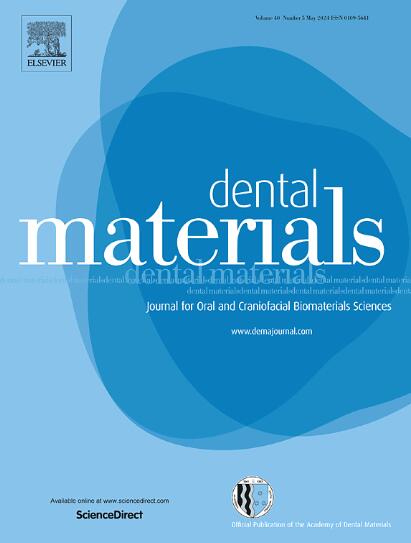目前生产耐用生物材料的方法:牙科修复用聚合材料的发展趋势。
IF 4.6
1区 医学
Q1 DENTISTRY, ORAL SURGERY & MEDICINE
引用次数: 0
摘要
遗憾的是,特别是随着人口老龄化的加剧,每年都有数十万颗树脂复合修复体因反复龋坏和断裂而被更换。根据多项队列研究,这种修复体的平均寿命为 10 年或更短,具体取决于患者的龋病风险水平和修复过程的复杂程度。任何新材料的开发都必须摆脱简单的外形修复模式,即充填物仅具有惰性/生物相容性。本综述将讨论新型的抗生物膜结构,这种结构是基于专门针对菌群失调的靶向方法。在非杀菌方法中,使用糖基转移酶(GTF)抑制剂可以防止生物膜凝聚。在牙齿基质方面,MMP 抑制分子可以提高混合层中胶原蛋白的稳定性。本综述还将讨论在生理相关环境中测试材料的重要性,模拟口腔中的机械负荷、细菌挑战和唾液存在等条件。归根结底,材料开发的目标是获得耐久的修复体,能够适应口腔环境并抵御超出机械要求的挑战。这样,我们就可以避免每次再治疗时不必要的额外牙齿结构损失。临床意义:虽然正确的修复技术以及饮食和口腔卫生方面的患者教育是延长直接美容修复体寿命的关键因素,但我们仍然需要能更好地抵抗口腔环境条件并与之相互作用的材料。用美学材料再现牙科汞合金的成功仍然是材料开发的圣杯。本文章由计算机程序翻译,如有差异,请以英文原文为准。
Current approaches to produce durable biomaterials: Trends in polymeric materials for restorative dentistry applications
Dental caries continues to be a public health issue, especially more evident in underserved populations throughout the U.S. Unfortunately, especially with an aging population, hundreds of thousands of resin composite restorations are replaced each year due to recurring decay and fracture. According to several cohort studies, the average life span of this type of restoration is 10 years or less, depending on the caries risk level of the patient and the complexity of the restorative procedure. Any new material development must depart from the simple restoration of form paradigm, in which the filling is simply inert/biocompatible. This review will discuss novel antibiofilm structures, based on a targeted approach specifically against dysbiotic bacteria. Biofilm coalescence can be prevented by using glycosyl transferase - GTF inhibitors, in a non-bactericidal approach. On the tooth substrate side, MMP-inhibiting molecules can improve the stability of the collagen in the hybrid layer. This review will also discuss the importance of testing the materials in a physiologically relevant environment, mimicking the conditions in the mouth in terms of mechanical loading, bacterial challenge, and the presence of saliva. Ultimately, the goal of materials development is to achieve durable restorations, capable of adapting to the oral environment and resisting challenges that go beyond mechanical demands. That way, we can prevent the unnecessary loss of additional tooth structure that comes with every re-treatment.
Clinical significance
While proper restorative technique and patient education in terms of diet and oral hygiene are crucial factors in increasing the longevity of esthetic direct restorations, materials better able to resist and interact with the conditions of the oral environment are still needed. Reproducing the success of dental amalgams with esthetic materials continues to be the Holy Grail of materials development.
求助全文
通过发布文献求助,成功后即可免费获取论文全文。
去求助
来源期刊

Dental Materials
工程技术-材料科学:生物材料
CiteScore
9.80
自引率
10.00%
发文量
290
审稿时长
67 days
期刊介绍:
Dental Materials publishes original research, review articles, and short communications.
Academy of Dental Materials members click here to register for free access to Dental Materials online.
The principal aim of Dental Materials is to promote rapid communication of scientific information between academia, industry, and the dental practitioner. Original Manuscripts on clinical and laboratory research of basic and applied character which focus on the properties or performance of dental materials or the reaction of host tissues to materials are given priority publication. Other acceptable topics include application technology in clinical dentistry and dental laboratory technology.
Comprehensive reviews and editorial commentaries on pertinent subjects will be considered.
 求助内容:
求助内容: 应助结果提醒方式:
应助结果提醒方式:


